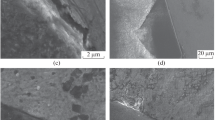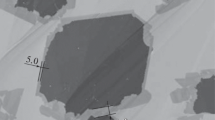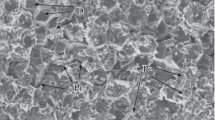A diamond – silicon carbide composite material has been obtained. The reaction-diffusion mechanism of Turing sintering is investigated. The conditions for the growth of SiC grains on diamond particles during formation of the composite are shown. The process of graphitization of diamond particles during reaction sintering has been investigated. The mechanical characteristics of the diamond – silicon carbide composite have been studied.






Similar content being viewed by others
References
R. Riedel, Handbook of Ceramic Hard Materials, Wiley-VCH, Weinheim, New York, 2000.
L. Schafer, Diamantbeschichtete Keramik DiaCer: Leistungsfähiger Werkstoffverbund für extreme Anforderungen, Diamond Business, 22 – 26 (2011).
M. Shimono and S. Kume, “HIP-sintered composites of C (diamond)/ SiC,” J. Am. Ceram. Soc., 87(4), 752 – 755 (2004).
O. Ohtaka, M. Shimono, N. Ohnishi, et al., “HIP production of a diamond/SiC composite and application to high-pressure anvils,” Phys. Earth Planet. Inter., 143, 587 – 591 (2004).
O. Ohtaka, N. Ohnishi, K. Kubo, et al., “High-pressure and high-temperature generation using diamond/SiC composite anvils prepared with hot isostatic pressing,” High Pressure Res., 25(1), 11 – 15 (2005).
Z. He, H. Katsui, and T. Goto, “High-hardness diamond composite consolidated by spark plasma sintering,” J. Am. Ceram. Soc., 99(6), 1862 – 1865 (2016).
M. Kitiwan, H. Katsui, and T. Goto, “Spark plasma sintering of SiC-coated large-size diamond powder,” Mater. Today: Proc., 4(11), 11453 – 11456 (2017).
S. Kume, K. Suzuki, H. Yoshida, et al., “Reaction sintering of Si coated-diamond fine particles under ultrahigh pressure,” Rev. High Pressure Sci. Technol., 7, 1010 – 1012 (1998).
Y. S. Ko, T. Tsurumi, O. Fukunaga, et al., “High pressure sintering of diamond-SiC composite,” J. Mater. Sci., 36(2), 469 – 475 (2001).
J. Qian, G. Voronin, T. W. Zerda, et al., “High-pressure, high-temperature sintering of diamond-SiC composites by ball-milled diamond-Si mixtures,” J. Mater. Res., 17(8), 2153 – 2160 (2002).
G. A. Voronin, T. W. Zerda, J. Gubicza, et al., “Properties of nanostructured diamond – silicon carbide composites sintered by high pressure infiltration technique,” J. Mater. Res., 19(9), 2703 – 2707 (2004).
C. Zhu, J. Lang, and N. Ma, “Preparation of Si – diamond-SiC composites by in-situ reactive sintering and their thermal properties,” Ceram. Int., 38(8), 6131 – 6136 (2012).
Y. Liu, C. Hu, J. Men, et al., “Effect of diamond content on microstructure and properties of diamond/SiC composites prepared by tape-casting and CVI process,” J. Eur. Ceram. Soc., 35(8), 2233 – 2242 (2015).
B. Matthey, S. Kunze, M. Horner, et al., “SiC-bonded diamond materials produced by pressureless silicon infiltration,” J. Mater. Res., 32(17), 3362 – 3371 (2017).
J. Li, Y. Liu, B. Nan, et al., “Microstructure and properties of C/SiC-diamond composites prepared by the combination of CVI and RMI,” Adv. Eng. Mater., 21(5), 1800765 (2019).
A. Taylor, L. Klimsa, J. Kopecek, et al., “Synthesis and properties of diamond – silicon carbide composite layers,” J. Alloys Compd., 800, 327 – 333 (2019).
W. F. Knippenberg, “Growth phenomena in silicon carbide,” Philips Res. Rep., 18, 161 – 274 (1963).
K. Mlungwane, I. J. Sigalas, and M. Herrmann, “The development of a diamond-silicon carbide composite material,” Ind. Diamond Rev., No. 4, 62 – 65 (2005).
K. Mlungwane, I. J. Sigalas, and M. Herrmann, “The wetting behaviour and reaction kinetics in diamond-silicon carbide systems,” Ceram. Int., 35(6), 2435 – 2441 (2009).
K. Mlungwane, M. Herrmann, and I. Sigalas, “The low-pressure infiltration of diamond by silicon to form diamond-silicon carbide composites,” J. Eur. Ceram. Soc., 28(1), 321 – 326 (2008).
V. Y. Shevchenko, M. V. Kovalchuk, A. S. Oryshchenko, et al., “New chemical technologies based on Turing reaction-diffusion processes,” Dokl. Chem., 496(2), 28 – 31 (2021).
V. Y. Shevchenko, S. N. Perevislov, V. L. Ugolkov, “Physicochemical interaction processes in the carbon (diamond)–silicon system,” Glass Phys. Chem., 47(3), 197 – 208 (2021).
V. Y. Shevchenko and S. N. Perevislov, “Reaction-diffusion mechanism of synthesis in the diamond-silicon carbide system,” Russ. J. Inorg. Chem., 66(8), 1107 – 1114 (2021).
A. Turing, “The chemical basis of morphogenesis,” Philos. Trans. R. Soc. London, Ser. B, 237(641), 37 – 72 (1952).
C. Zollfrank and H. Sieber, “Microstructure evolution and reaction mechanism of biomorphous SiSiC ceramics,” J. Am. Ceram. Soc., 88(1), 51 – 58 (2005).
V. Y. Shevchenko, M. V. Koval’chuk, and A. S. Oryshchenko, “Synthesis of a new class of materials with a regular (periodic) interconnected microstructure,” Glass Phys. Chem., 45(6), 412 – 418 (2019).
J. S. Park, R. Sinclair, D. Rowcliffe, et al., “Orientation relationship in diamond and silicon carbide composites,” Diamond Relat. Mater., 16(3), 562 – 565 (2007).
V. R. Howes, “The graphitization of diamond,” Proc. Phys. Soc., 80(3), 648 (1962).
J. W. Harris and E. R. Vance, “Induced graphitisation around crystalline inclusions in diamond,” Contrib. Mineral. Petrol., 35(3), 227 – 234 (1972).
T. Evans and D. H. Sauter, “Etching of diamond surfaces with gases,” Philos. Mag., 6(63), 429 – 440 (1961).
S. Dallek, L. Kabacoff, and M. Norr, “Oxidation kinetics of type 2A natural diamond {100} and {111} surfaces by TG,” Thermochim. Acta, 192, 321 – 326 (1991).
Q. Sun and M. Alam, “Relative oxidation behavior of chemical vapor deposited and type II a natural diamonds,” J. Electrochem. Soc., 139(3), 933 – 936 (1992).
W. J. P. von Enckewort and F. K. de Theije, “Etching of diamond,” in: M. H. Nazare and A. J. Neves (eds.), Properties, Growth and Applications of Diamond, emis Datareviews Series No. 26, INSPEC, The Institution of Electrical Engineers, London, UK, 2001, pp. 115 – 124.
R. A. Khmelnitsky and A. A. Gippius, “Transformation of diamond to graphite under heat treatment at low pressure,” Phase Transitions, 87(2), 175 – 192 (2014).
J. K. Lewis, H. Chen, S. Nafis, et al., “High temperature graphitization of diamond,” Proc. Electrochem. Soc., 91(8), 455 – 462 (1991).
V. Ya. Shevchenko, Introduction to Technical Ceramics [in Russian], Nauka, Moscow, 1993, 114 pp.
D. D. Nesmelov and S. N. Perevislov, “Reaction sintered materials based on boron carbide and silicon carbide,” Glass Ceram., 71(9/10), 313 – 319 (2015).
S. N. Perevislov, M. V. Tomkovich, M. A. Markov, et al., “The influence of dispersed composition of SiC on the physico-mechanical properties of reactive-sintered silicon carbide,” J. Mach. Manuf. Reliab., 49(6), 511 – 517 (2020).
D. D. Nesmelov, O. A. Kozhevnikov, S. S. Ordan’yan, et al., “Precipitation of the eutectic Al2O3–ZrO2(Y2O3) on the surface of SiC particles,” Glass Ceram., 74(1), 43 – 47 (2017).
S. N. Perevislov, A. S. Lysenkov, and S. V. Vikhman, “Effect of Si additions on the microstructure and mechanical properties of hot-pressed B4C,” Inorg. Mater., 53(4), 376 – 380 (2017).
S. N. Perevislov, P. V. Shcherbak, and M. V. Tomkovich, “High density boron carbide ceramics,” Refract. Ind. Ceram., 59(1), 32 – 36 (2018).
S. N. Perevislov, P. V. Shcherbak, and M. V. Tomkovich, “Phase composition and microstructure of reaction-bonded boron-carbide materials,” Refract. Ind. Ceram., 59, No. 2, 179 – 183 (2018).
S. N. Perevislov, A. S. Lysenkov, D. D. Titov, et al., “Materials based on boron carbide obtained by reaction sintering,” IOP Conf. Ser.: Mater. Sci. Eng., 525(1), 012074 (2019).
Author information
Authors and Affiliations
Corresponding author
Additional information
Translated from Novye Ogneupory, No. 9, pp. 48 – 54, September, 2021.
Rights and permissions
About this article
Cite this article
Shevchenko, V.Y., Perevislov, S.N. Microstructure and Properties of Composite Materials Diamond – Silicon Carbide. Refract Ind Ceram 62, 548–553 (2022). https://doi.org/10.1007/s11148-022-00640-w
Received:
Published:
Issue Date:
DOI: https://doi.org/10.1007/s11148-022-00640-w




